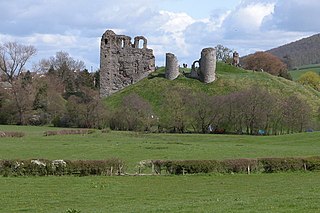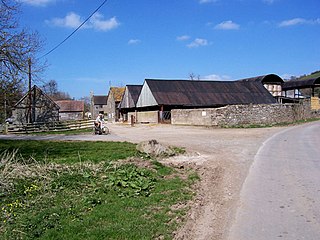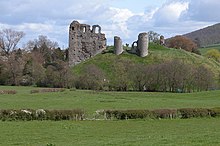
Stokesay Castle is one of the finest surviving fortified manor houses in England, and situated at Stokesay in Shropshire. It was largely built in its present form in the late 13th century by Laurence of Ludlow, on the earlier castle founded by its original owners the de Lacy family, from whom it passed to their de Verdun heirs, who retained feudal overlordship of Stokesay until at least 1317. Laurence 'of' Ludlow was one of the leading wool merchants in England, who intended it to form a secure private house and generate income as a commercial estate. Laurence's descendants continued to own the castle until the 16th century, when it passed through various private owners. By the time of the outbreak of the First English Civil War in 1642, Stokesay was owned by William Craven, 1st Earl of Craven (1608–1697), a supporter of King Charles I. After the Royalist war effort collapsed in 1645, Parliamentary forces besieged the castle in June and quickly forced its garrison to surrender. Parliament ordered the property to be slighted, but only minor damage was done to the walls, allowing Stokesay to continue to be used as a house by the Baldwyn family until the end of the 17th century.

Clun is a town in south west Shropshire, England, and the Shropshire Hills Area of Outstanding Natural Beauty. The 2011 census recorded 680 people living in the town. Research by the Campaign for the Protection of Rural England suggests that Clun is one of the most tranquil locations in England.

Clun Castle is a medieval ruined castle in Clun, Shropshire, England. Clun Castle was established by the Norman lord Robert de Say after the Norman invasion of England and went on to become an important Marcher lord castle in the 12th century, with an extensive castle-guard system. Owned for many years by the Fitzalan family, Clun played a key part in protecting the region from Welsh attack until it was gradually abandoned as a property in favour of the more luxurious Arundel Castle. The Fitzalans converted Clun Castle into a hunting lodge in the 14th century, complete with pleasure gardens, but by the 16th century the castle was largely ruined. Slighted in 1646 after the English Civil War, Clun remained in poor condition until renovation work in the 1890s.
Shropshire was established during the division of Saxon Mercia into shires in the 10th century. It is first mentioned in 1006. After the Norman Conquest it experienced significant development, following the granting of the principal estates of the county to eminent Normans, such as Roger De Montgomery and his son Robert de Bellême.

Fulk FitzWarin, variant spellings, the third, was a prominent representative of a marcher family associated especially with estates in Shropshire and at Alveston in Gloucestershire. In young life, early in the reign of King John (1199–1216), he won notoriety as the outlawed leader of a roving force striving to recover his familial right to Whittington Castle in Shropshire, which John had granted away to a Welsh claimant. Progressively rehabilitated, and enjoying his lordship, he endured further setbacks in 1215–1217.
Walter de Clifford (1113–1190) was an Anglo-Norman Marcher Lord of Bronllys Castle on the Welsh border, and was feudal baron of Clifford, seated at Clifford Castle in Herefordshire.

Bicton is a hamlet in southwest Shropshire, England, one mile north of Clun. The short River Unk passes through the hamlet. In previous centuries it was a township in the Clun division of the hundred of Clun.
Walter Fitz Robert of Woodham Walter, lord of Little Dunmow, Essex, was steward under Stephen of England, having succeeded to that position upon the death of his father, Robert Fitz Richard. Walter died in 1198 and was buried at Little Dunmow, in the choir of the priory of Austin canons.
Alan fitz Flaad was a Breton knight, probably recruited as a mercenary by Henry I of England in his conflicts with his brothers. After Henry became King of England, Alan became an assiduous courtier and obtained large estates in Norfolk, Sussex, Shropshire, and elsewhere in the Midlands, including the feudal barony and castle of Oswestry in Shropshire. His duties included supervision of the Welsh border. He is now noted as the progenitor of the FitzAlan family, the Earls of Arundel (1267–1580), and the House of Stuart, although his family connections were long a matter of conjecture and controversy.

FitzAlan is an English patronymic surname of Anglo-Norman origin, descending from the Breton knight Alan fitz Flaad, who accompanied king Henry I to England on his succession. He was grandson of the Seneschal of the Bishop of Dol. The FitzAlan family shared a common patrilineal ancestry with the House of Stuart.

Henry de Say was a Norman nobleman who lived in Clun near Shrewsbury, along the medieval Welsh Marches.
Isabella de Say was an Anglo-Norman heiress. Isabella was the only surviving child of Helias de Say upon his death in 1165; Helias was the third lord of Clun, a powerful Norman stronghold in Shropshire, England, along the Welsh border. She is notable for helping to create the powerful medieval house of the FitzAlans. Isabella married William FitzAlan, the lord of nearby Oswestry, as his second wife in 1156. William died in 1160, leaving a son by his first wife, Christiana, William FitzAlan II. Isabella passed Clun Castle to him. The combined lordship of Oswestry and Clun was a significant power in the borderlands with Wales.
William Fitz Alan was a Norman nobleman who lived in Oswestry and Clun near Shrewsbury, along the medieval Welsh Marches. William was the son of William Fitz Allan, controlling the castles of Clun and Oswestry and later became the High Sheriff of Shropshire. William married a daughter of Hugh de Lacy, of which no first name is mentioned in any record known. When William came to inherit his lands in 1210, King John demanded a fee of 10,000 marks; unable to pay, William was unable to inherit. He only outlived his father by a few years, dying around Easter 1215. The estates were eventually reclaimed by his younger brother John Fitzalan.

Josce de Dinan was an Anglo-Norman nobleman who lived during and after the civil war between King Stephen of England and his cousin Matilda over the throne of England. He was a landholder in the Welsh Marches when he was married by Stephen to the widow of Pain fitzJohn, a union that gave Josce control of Ludlow Castle. Control of the castle was contested by other noblemen, and the resulting warfare between the nobles forms the background to a late medieval romance known as Fouke le Fitz Waryn, which is mainly concerned with the actions of Josce's grandson, but also includes some material on Josce's lifetime. Josce eventually lost control of Ludlow and was granted lands in compensation by Matilda and her son, King Henry II of England, who succeeded Stephen in 1154.
William FitzAlan (1105–1160) was a nobleman of Breton ancestry. He was a major landowner, a Marcher lord with large holdings in Shropshire, where he was the Lord of Oswestry, as well as in Norfolk and Sussex. He took the side of Empress Matilda during the Anarchy and underwent considerable hardship in the Angevin cause before regaining his lands and former status. William's younger brother, Walter fitz Alan, became ancestor of the royal House of Stuart.
William Pantulf was an Anglo-Norman nobleman and Baron of Wem. He was born in Hiémois, a county of Normandy, where his family had lived since around 1030. Pantulf held lands in Shropshire following the Norman Conquest of England. A vassal of Roger of Montgomery, the Earl of Shrewsbury, Pantulf was accused of murdering Roger's wife but proved his innocence of the charge by a trial by ordeal. When Roger's son Robert of Belleme rebelled against King Henry I of England, Pantulf did not take part and sided with the king. Upon his death, which most likely occurred in 1112, William's eldest son Philip inherited his Norman lands, and his second son Robert received the English lands.
William FitzAlan was a Norman nobleman who lived in Oswestry and Clun near Shrewsbury, along the medieval Welsh Marches. William was the son of William FitzAlan, controlling the castles of Clun and Oswestry and later became the High Sheriff of Shropshire. Many people today will often confuse William with his father, as their death dates are similar by 5 years. Because of this, it is important to know that this William was married to Mary Erington, the daughter of Thomas. William's father William married the daughter of Hugh de Lacy, whose name is never mentioned in any documents. When William came to inherit his lands in 1210, King John demanded a fee of 10,000 marks; unable to pay, William was unable to inherit. He only outlived his father by a few years, dying around Easter 1215. The estates were eventually reclaimed by his younger brother John Fitzalan.
William FitzAlan was a Norman nobleman who lived in Oswestry and Clun, near Shrewsbury, along the medieval Welsh Marches. William was the son of William FitzAlan and Christina.

The de Warenne family were a noble family in England that included the first Earls of Surrey, created by William the Conqueror in 1088 for William de Warenne, 1st Earl of Surrey, who was among his companions at the Battle of Hastings. The family originated in Normandy and, as Earls, held land there and throughout England. When the senior male-line ended in the mid-12th century, the descendants of their heiress adopted the Warenne surname and continue as Earls of Surrey for another two centuries. Several junior lines also held land or prominent offices in England and Normandy.
Ivo Pantulf was an Anglo-Norman nobleman and feudal baron of Wem in Shropshire.










